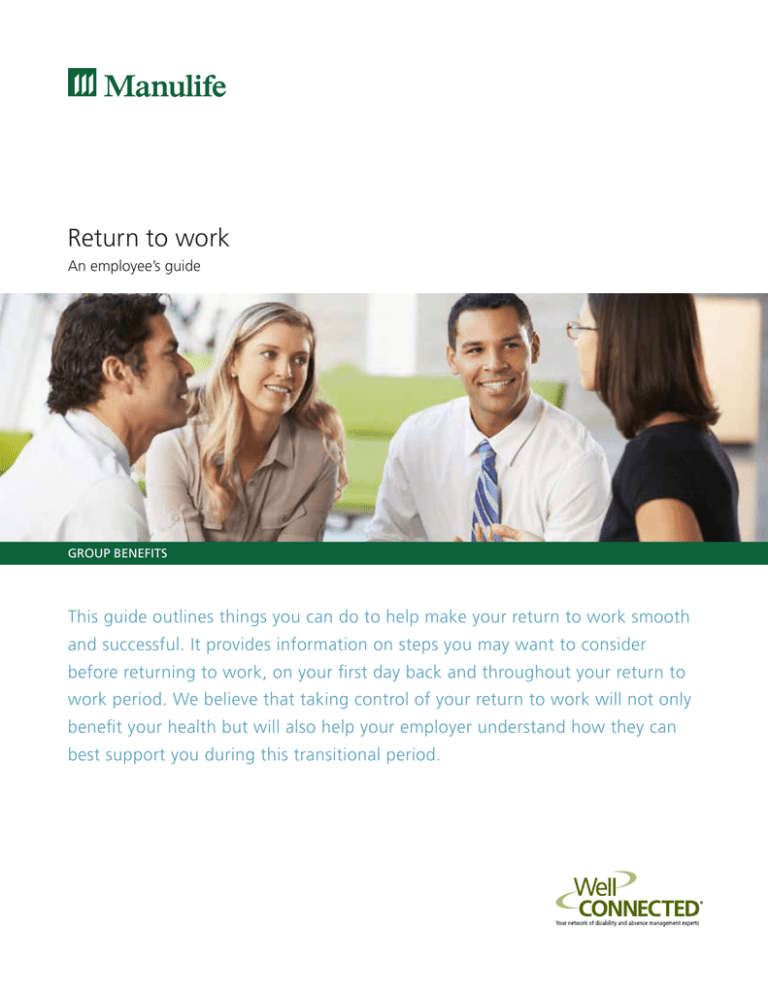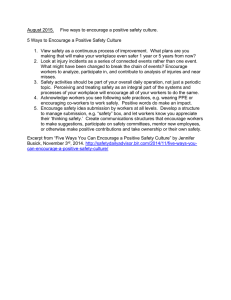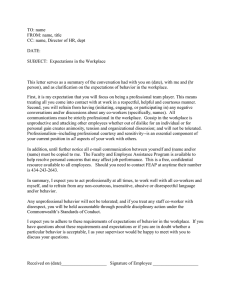
Return to work
An employee’s guide
Group Benefits
This guide outlines things you can do to help make your return to work smooth
and successful. It provides information on steps you may want to consider
before returning to work, on your first day back and throughout your return to
work period. We believe that taking control of your return to work will not only
benefit your health but will also help your employer understand how they can
best support you during this transitional period.
Key concepts to help you successfully
manage your return to work
Helpful tips:
■■
1) Work is a key part of your recovery.
■■ The day-to-day physical and mental demands of work
can help to recondition yourself following an absence.
■■
■■
The workplace provides the structure and routine
necessary to facilitate a successful recovery.
Gradually incorporating work demands into your
recovery may help to improve your chances of
staying healthy. Work may benefit your overall
health by providing structure and routine, social
interaction and a sense of accomplishment.
■■
■■
2) Returning to work often requires an
adjustment period.
■■
■■
You may not be able to fully perform the physical and
mental demands of your job in the same way as prior
to the onset of your condition. At times you may be
frustrated, tired and worried about whether or not
you can be successful.
■■
■■
■■
You may require an accommodation to help you
gradually reintegrate into the hours and duties
required for your job.
How do I get ready for my return
to work?
Preparing to return to work may seem overwhelming,
especially after being away from the workplace for
an extended period of time. To help make your return
to work successful, it is important that you engage in
the process as much as possible. Stay connected with
your health care providers, and your Manulife Disability
Case Manager and Rehabilitation Specialist (if one
is assigned). Talk to them about how you envision
your return to work, your worries or concerns about
returning, your motivation, your thoughts about what
you can do to prepare and what you will need to assist
your transition back to the workplace. They are available
to help you.
■■
■■
Clearly understand the return to work plan. What are
the hours? What work tasks are you responsible for?
Who do you need to communicate with? Be an active
participant in the process and planning of your return
to work.
Take steps to address problems early. If there are
workplace factors that may affect or exacerbate
your condition, take steps to deal with them. This
may mean talking to your manager and/or Human
Resources representative or developing strategies to
deal with stressful situations positively and proactively.
If you have been away for an extended period of time,
it may be helpful to talk to your manager about any
training you may need to effectively complete your
work tasks.
Know where to go if you have questions or concerns.
Establish what, if anything, you will communicate to
others about your absence.
Develop support resources. Take an inventory of your
existing support system. Your support system may
include your doctors and your Manulife Disability
Case Manager and/or Rehabilitation Specialist. It may
also include your Employee Assistance Program, your
Human Resources representative at work, family,
friends and community. Know that you will need extra
support during the return to work. This can mean
informing family, friends, physicians or other health
care providers about your return and letting them
know how they may be of help to you.
Get regular exercise every day and maintain a
healthy diet.
Establish a healthy sleeping routine.
Returning to work following an absence can often be the most critical phase of your recovery.
How you handle the transition back to work may determine how successful you will be. Fortunately
there are many things you can do to help prepare for a successful reintegration into the workplace.
2
What kind of accommodations can
I expect?
The purpose of workplace accommodations is to help
remove return to work barriers for individuals with
disabilities. Accommodations should be assessed on an
individual basis. They should meet your needs as they
relate to your medical condition and they should be
based on the resources available to your employer.
Accommodation examples may include (but are not
limited to) the following:
■■ Hours – graduated return to work, flex time to attend
appointments, balance work/life, non-standard breaks
during the work day.
■■
■■
■■
■■
Duties – modification of work tasks, elimination of
non-essential tasks during the return to work, allowing
extra time to complete tasks.
Modification of work environment – lighting, noise
or other distractions.
Supervision – changing the way direction is provided
(e.g., in writing or allowing you to tape record),
prioritization of tasks.
Additional training or coaching – providing a buddy
system for additional support.
What should I do on my first day back?
Your first day back at work is a big step in the right
direction, especially if you have a plan. Here are some
tips that may help make it successful:
■■
■■
■■
■■
■■
Review the return to work plan with your manager
to help ensure you both understand it, including how
you will evaluate success and address issues.
Discuss things like workload, job duties and
performance to clarify your expectations and your
managers expectations align.
Discuss any extra training or reintegration
time/resources that may be required.
Validate that you have an easily accessible list of
resources should you run into difficulties or begin
to feel overwhelmed.
Try to get back into a regular work routine.
What should I tell my manager?
Your manager plays a critical role in your return to work.
Maintain an open and honest approach. Assess your
situation and decide what you should tell your manager.
A few suggested considerations and reflections are
as follows:
■■
A “one size fits all” approach will not work. We believe
the accommodation for your personal situation should
be assessed accordingly.
■■
■■
What are you comfortable telling your manager?
Keep in mind that saying nothing can lead to problems
as they might mistakenly confuse your medical
condition with performance problems. Find a balance
between your own privacy and helping your manager
understand your situation.
Keep details to a minimum. Use general terms like
illness or disability versus the specific diagnosis and/or
treatment. It is entirely at your discretion in terms of
how much information you are comfortable disclosing
to your manager.
How does your medical condition affect your ability
to work?
3
■■
■■
■■
■■
How can your manager help? This may involve
workplace accommodations, looking out for signs
of problems, identifying situations that may be more
difficult or challenging, and the best way for them to
communicate with you if they have concerns.
■■
Is your employer able to provide additional support
and resources?
Take the opportunity to reinforce your skills, abilities
and commitment to the company.
Once you have established what you will share with
your manager, you may want to consider discussing
with them how to approach communicating with
co-workers about your situation.
What should I tell my co-workers?
Your approach to talking to your co-workers will depend
highly on what you deem to be appropriate. Details
of your absence are private and confidential. Only you
can determine whether or not you want to share this
information, and with whom. If you are unsure of the
best approach, talk to a third party such as Human
Resources or Employee Health when available.
What if I am having difficulties during my
return to work?
Despite being prepared to return to work, you may
encounter hurdles along the way. To help avoid a
setback, you may want to keep in mind a few of the
following considerations:
■■
■■
Recognize the early signs of trouble. These may
include, getting easily agitated or frustrated with
others or with tasks, not being able to block out
distractions, having difficulty focusing, or simply not
performing to the level you are used to.
■■
■■
■■
■■
Have a plan to immediately deal with frustrations. Take
a break or go for a walk. Inform your manager ahead
of time so they are aware this may happen.
Be aware of and use the resources at your
disposal – your physician or other health care
providers, Employee Assistance Program, your
Manulife Rehabilitation Specialist and/or Disability
Case Manager.
If there are workplace factors causing problems,
proactively address these with your manager and
come up with solutions together.
Address problems early so they don’t negatively
impact your recovery.
Determine if changes/adjustments may be made to the
return to work plan.
It is important to always maintain focus on your
recovery. After returning to work, continue with your
treatment and see your health care providers regularly,
or as needed.
Where can I go if I need more support?
■■
Understand what resources your employer has available
(Employee Assistance Program, etc.).
■■
Your Physician or Therapist (if you are seeing one).
■■
Some helpful online resources:
––www.mentalhealthworks.ca
(Mental Health Works – a great resource for tools, tips
and information on mental health and the workplace)
––http://www.iwh.on.ca
(Institute for Health and Work – a non-profit
organization dedicated to promoting, protecting
and improving the health of workers)
––http://www.phac-aspc.gc.ca/chn-rcs
(Public Health Agency of Canada)
Please be advised that the contents of this brochure are for informational and educational purposes only and should in no way be considered as Manulife Group Benefits offering medical advice. Please consult with
your attending family physician(s) or other health care provider(s) as may be needed. WellConnected® is offered through Manulife. Manulife is not responsible for the availability or content of external websites.
© 2015 The Manufacturers Life Insurance Company. All rights reserved. Manulife and the Block Design are trademarks of The Manufacturers Life Insurance Company and are used by it, and by its affiliates
under license.
GC2328E 06/15





